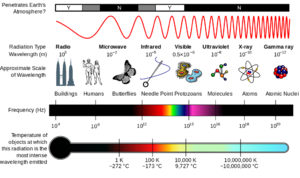Infrared Therapy: Difference between revisions
No edit summary |
No edit summary |
||
| Line 5: | Line 5: | ||
</div> | </div> | ||
== Introduction == | == Introduction == | ||
Thermal radiation or Infrared is a band of energy in the complete electromagnetic spectrum and it has been used effectively for millennia to treat/ease certain maladies and discomforts. Infrared are the radiations of longer wavelength than the red end of the visible spectrum and extending to the microwave region, i.e. from 760 nm to 1 mm.<ref>Infrare dand visible radiations. Electrotherapy Explained principles and practice. John Low & Ann Reed. 2nd edition.</ref> | Thermal radiation or Infrared is a band of energy in the complete electromagnetic spectrum and it has been used effectively for millennia to treat/ease certain maladies and discomforts. Infrared are the radiations of longer wavelength than the red end of the visible spectrum and extending to the microwave region, i.e. from 760 nm to 1 mm.<ref name=":1">Infrare dand visible radiations. Electrotherapy Explained principles and practice. John Low & Ann Reed. 2nd edition.</ref> | ||
[[File:ElectroMagnetic Spectrum Properties.png|thumb|Electromagnetic Spectrum]] | [[File:ElectroMagnetic Spectrum Properties.png|thumb|Electromagnetic Spectrum]] | ||
| Line 28: | Line 28: | ||
|} | |} | ||
An alternative classification provided in ISO 20473 <ref name=":0" /> | An alternative classification provided in ISO 20473 <ref name=":0" /> | ||
Infrared radiations are produced by various kinds vibrations in the molecules; the molecular movement causes infrared emission of different wavelengths<ref name=":1" />. The Near infrared are also known as 'Luminous' as they have some visible light with wavelength of 770 to 1500 nanometers.<ref>Thermal agents in rehabilitation. Chapter 5 Biophysical Principles of heating.</ref> The Far infrared also called as non-luminous are within 1500nm to 0.1 mm. | |||
== Physiological Effects == | == Physiological Effects == | ||
Revision as of 08:29, 22 June 2021
Original Editor - User Name
Top Contributors - Vidya Acharya, Cindy John-Chu, Sai Kripa and Kim Jackson
Introduction[edit | edit source]
Thermal radiation or Infrared is a band of energy in the complete electromagnetic spectrum and it has been used effectively for millennia to treat/ease certain maladies and discomforts. Infrared are the radiations of longer wavelength than the red end of the visible spectrum and extending to the microwave region, i.e. from 760 nm to 1 mm.[1]
Infrared (IR) is a type of electromagnetic radiation, including wavelengths between the 780 nm to 1000 μm. IR is divided into different bands: Near-Infrared (NIR, 0.78~3.0 μm), Mid-Infrared (MIR, 3.0~50.0 μm) and Far-Infrared (FIR, 50.0~1000.0 μm) as defined in standard ISO 20473:2007 Optics and photonics -- Spectral bands.[2]
Classification
The classification of the International Commission on Illumination (CIE) has three sub-divisions for the IR radiation[3]
| Type | Wavelength |
|---|---|
| IR A (Near IR) | 700-1400nm |
| IR B (Mid-IR) | 1400-3000nm |
| IR C (Far-IR) | 3000 nm– 0.1 mm |
An alternative classification provided in ISO 20473 [3]
Infrared radiations are produced by various kinds vibrations in the molecules; the molecular movement causes infrared emission of different wavelengths[1]. The Near infrared are also known as 'Luminous' as they have some visible light with wavelength of 770 to 1500 nanometers.[4] The Far infrared also called as non-luminous are within 1500nm to 0.1 mm.
Physiological Effects[edit | edit source]
Therapeutic Uses[edit | edit source]
Application[edit | edit source]
Contraindication[edit | edit source]
Precautions[edit | edit source]
Resources[edit | edit source]
- bulleted list
- x
or
- numbered list
- x
References[edit | edit source]
- ↑ 1.0 1.1 Infrare dand visible radiations. Electrotherapy Explained principles and practice. John Low & Ann Reed. 2nd edition.
- ↑ Tsai SR, Hamblin MR. Biological effects and medical applications of infrared radiation. Journal of Photochemistry and Photobiology B: Biology. 2017 May 1;170:197-207.
- ↑ 3.0 3.1 Vatansever F, Hamblin MR. Far infrared radiation (FIR): its biological effects and medical applications. Photonics & lasers in medicine. 2012 Nov 1;1(4):255-66.
- ↑ Thermal agents in rehabilitation. Chapter 5 Biophysical Principles of heating.







